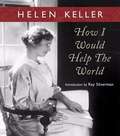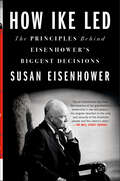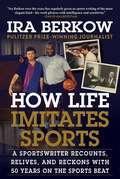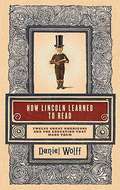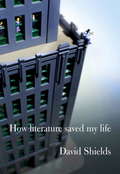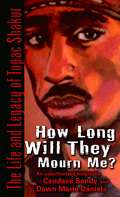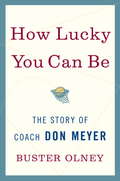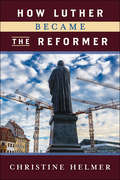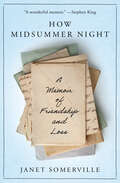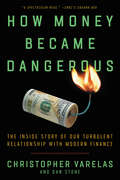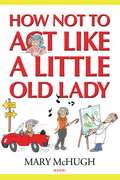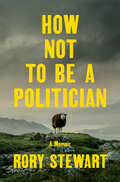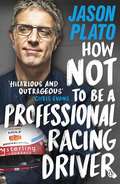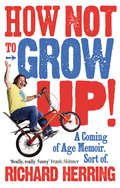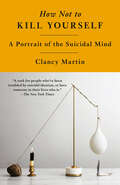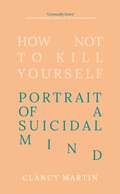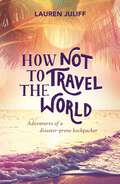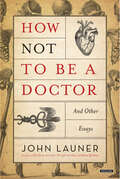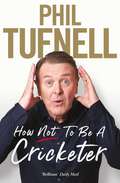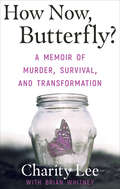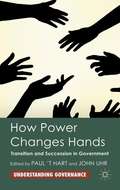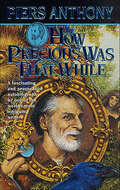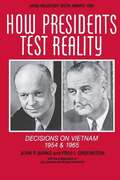- Table View
- List View
How I Would Help the World
by Helen Keller Ray SilvermanHelen Keller's life was deeply changed when she began to read the writings of Emanuel Swedenborg in braille. Referring to him as "one of the noblest champions true Christianity has ever known," she said, "Swedenborg's message has been my greatest incitement to overcome limitations." Certainly, Helen Keller did much to help the world. But she felt she could help the world most by sharing with others the inspiration that came to her through reading Swedenborg's books. "Were I but capable," she said, "of interpreting to others one-half of the stimulating thoughts and noble sentiments that are buried in Swedenborg's writings, I should help them more than I am ever likely to in any other way. It would be such a joy to me if I might be the instrument of bringing Swedenborg to a world that is spiritually deaf and blind." Her essay, How I Would Help the World, is her attempt to do this. It is accompanied by an introduction by scholar Ray Silverman elucidating Helen Keller's spiritual process. This glimpse into the spiritual life of Helen Keller provides inspiration for those who may have wondered how she was able to find the strength and courage to overcome her triple handicap. Pictures of Helen Keller and direct quotations from the writings of Emanuel Swedenborg accompany her poignant words.
How Ike Led: The Principles Behind Eisenhower's Biggest Decisions
by Susan Eisenhower“Lays bare the essence of [President Eisenhower’s] leadership in war and peace—his singular devotion to the unity and security of the American people.” —The Wall Street JournalFew leaders have made decisions as momentous—and varied—as Dwight D. Eisenhower. From D-Day to Little Rock, from the Korean War to Cold War crises, from the Red Scare to the Missile Gap controversies, Ike was able to give our country eight years of peace and prosperity by relying on a core set of principles. These were informed by his heritage and upbringing, as well as his strong character and personal discipline—but he also avoided making himself the center of things. He was a man of judgment, and a steadying force. He sought national unity by pursuing a course he called the “Middle Way” that tried to make winners on both sides of any issue.Ike was a strategic, not an operational leader, who relied on a rigorous pursuit of the facts for decision-making. His talent for envisioning a whole, especially in the context of the long game, and his ability to see causes and various consequences, explains his success as Allied Commander and as President. After making a decision, he made himself accountable for it, recognizing that personal responsibility is the bedrock of sound principles.Written by his granddaughter, a policy analyst and national security expert, How Ike Led reveals the personality, beliefs, and habits that allowed Eisenhower to lead America through a transformational time.“As good a picture of Ike as we have ever had.” —David Nichols, author of Eisenhower 1956“Highly personal anecdotes supplement [the author’s] research. Armchair historians will treasure this book.” —BooklistIncludes photographs
How It Goes in Mexico: Essays from an Expatriate
by Carol MerchasinCarol Merchasin first visited San Miguel de Allende in 2005, fell in love with its language, people, and culture, and moved there full-time with her husband shortly thereafter. A lawyer by training, Merchasin is curious about how everything around her in Mexico works—the health care system, religious rituals, loaning money, small change at the market, narcotrafficantes, telenovelas, and the subtleties between the verbs ser and estar. An intrepid researcher, she informally consults her neighbors, history books, and experts until she&’s satisfied. In How It Goes in Mexico, her essays are by turns funny and poignant, and her portrayal of Mexico is neither romantic nor wary, but respectful and compassionate.
How Life Imitates Sports: A Sportswriter Recounts, Relives, and Reckons with 50 Years on the Sports Beat
by Ira BerkowMemorable Stories From a Half Century of Sports Journalism For the last half century, Pulitzer Prize–winning sportswriter Ira Berkow has been at the center of some of the most memorable moments in sports history. From the World Series, NBA Finals, and Super Bowl, to Heavyweight Title Fights, the Olympics, and The Masters, he has seen and covered them all. After fifty years covering sports, with more than twenty-five as a journalist for the New York Times, How Life Imitates Sports shares how these events—and their participants—have significantly shaped how we as a nation have come to understand and perceive our culture (and even our politics). They are a historical record of one significant sphere of our life and times: sports. From Muhammad Ali to Mike Tyson, Michael Jordan to LeBron James, Jackie Robinson to Derek Jeter, Billie Jean King to Tonya Harding, O. J. Simpson to Tiger Woods and beyond, this collection is a historical record of our times over this past half century, in terms of society, race and gender, politics, legal issues, and the fabric of our sports passions and human condition, ranging from pathos to humor, from introspection to perception. Including additional commentary on when these events first occurred and how they have impacted us today, Berkow shares the knowledge of someone who sat ringside, in the press box, and on the sidelines for some of the most notable moments in our history. So whether you&’re a fan of baseball and basketball, or tennis and soccer, How Life Imitates Sports shows you our history from someone who witnessed it first-hand; a worthy collection for anyone who appreciates the highest quality sports journalism.
How Lincoln Learned to Read: Twelve Great Americans and the Educations That Made Them
by Daniel WolffBeginning with Benjamin Franklin and ending with Elvis Presley, author Daniel Wolff creates a series of intimate, interlocking profiles of notable Americans that track the nations developing notion of what it means to get a good education.
How Literature Saved My Life
by David Shields"Reading How Literature Saved My Life is like getting to listen in on a really great, smart, provocative conversation. The book is not straightforward, it resists any single interpretation, and it seems to me to constitute nothing less than a new form." --Whitney Otto In this wonderfully intelligent, stunningly honest, painfully funny book, acclaimed writer David Shields uses himself as a representative for all readers and writers who seek to find salvation in literature. Blending confessional criticism and anthropological autobiography, Shields explores the power of literature (from Blaise Pascal's Pensées to Maggie Nelson's Bluets, Renata Adler's Speedboat to Proust's Remembrance of Things Past) to make life survivable, maybe even endurable. Shields evokes his deeply divided personality (his "ridiculous" ambivalence), his character flaws, his woes, his serious despairs. Books are his life raft, but when they come to feel un-lifelike and archaic, he revels in a new kind of art that is based heavily on quotation and consciousness. And he shares with us a final irony: he wants "literature to assuage human loneliness, but nothing can assuage human loneliness. Literature doesn't lie about this--which is what makes it essential." A captivating, thought-provoking, utterly original way of thinking about the essential acts of reading and writing.
How Long Will They Mourn Me?: The Life and Legacy of Tupac Shakur
by Dawn Marie Daniels Candace Sandy"Buried as a g while tha whole world remembers me" -Tupac Shakur, from "Until the End of Time" Tupac Shakur was larger than life. A gifted rapper, actor, and poet, he was fearless, prolific, and controversial-and often said that he never expected to live past the age of thirty. He was right. On September 13, 1996, he died of gunshot wounds at age twenty-five. But even ten years after Tupac's tragic passing, the impact of his life and talent continues to flourish. Lauded as one of the greatest hip-hop artists of all time, Tupac has sold more than sixty-seven million records worldwide, making him the top-selling rapper ever. How Long Will They Mourn Me? celebrates Tupac's unforgettable life-his rise to fame; his tumultuous dark side marked by sex, drugs, and violence; and the indelible legacy he left behind. Although Tupac's murder remains unsolved, the spirit of this legendary artist is far from forgotten. How long will we mourn him? Fans worldwide will grieve his untimely death for a long time to come.
How Lucky You Can Be: The Story of Coach Don Meyer
by Buster OlneyIn September 2008, Northern State University men#x19;s basketball coach Don Meyer stood on the brink of immortality. He was about to surpass the legendary Bobby Knight to become the all-time NCAA wins leader in men#x19;s basketball. Then, on a two-lane road in South Dakota, everything changed in an instant. InHow Lucky You Can Be, acclaimed sports journalist Buster Olney tells the remarkable story of the successive tragedies that befell Coach Meyer but could not defeat him. Laid low by a horrific car accident that led to the amputation of his left leg below the knee, Coach Meyer had barely emerged from surgery when his doctors informed him that he also had terminal cancer. In the blink of an eye, this prototypical 24/7 workaholic coach-who arrived at the gym most mornings before 6 a. m. -found himself forced to reexamine his priorities at the age of sixty-three. A model of reserve, Coach Meyer had sacrificed much of his emotional life to his program. His wife, Carmen, felt disconnected because of his habitual reticence, while his three children-all now well into adulthood-had long had to compete with basketball for his attention. With sensitivity and skill, Olney shows how Coach Meyer mined his physical ordeal for the spiritual strength to transform his life. In the months that followed his accident and diagnosis, he reached out to family, friends, and former players in a way he had never been able to do before, making the most of this one last opportunity to tell those close to him how he felt about them-and in turn he received an outpouring of affirmation that confirmed how deeply he had affected others. Sustained throughout an often painful recovery by his love of basketball, he would return to the court once more-with a newfound appreciation for the game#x19;s place in his life. The inspirational story of a life renewed by unimaginable hardship,How Lucky You Can Beproves that it#x19;s never too late to start making changes-and reminds us that fortune can smile upon us even in our most trying hours. From the Hardcover edition.
How Luther Became the Reformer
by Christine HelmerNo story has been more foundational to triumphalist accounts of Western modernity than that of Martin Luther, the heroic individual, standing before the tribunes of medieval authoritarianism to proclaim his religious and intellectual freedom, “Here I stand!” How Luther Became the Reformer returns to the birthplace of this origin myth, Germany in the late nineteenth century, and traces its development from the end of World War I through the rise of National Socialism. Why were German intellectuals—especially Protestant scholars of religion, culture, and theology—in this turbulent period so committed to this version of Luther’s story? Luther was touted as the mythological figure to promote the cultural unity of Germany as a modern nation; in the myth’s many retellings, from the time of the Weimar Republic forward, Luther attained world-historical status. Helmer finds in this construction of Luther the Reformer a lens through which to examine modernity’s deformations, among them anti-Judaism, anti-Semitism, and anti-Catholicism. Offering a new interpretation of Luther, and by extension of modernity itself, from an ecumenical perspective, How Luther Became the Reformer provides resources for understanding and contesting contemporary assaults on democracy. In this way, the book holds the promise for resistance and hope in dark times.
How Medicine Works and When It Doesn't: Learning Who to Trust to Get and Stay Healthy
by F. Perry WilsonBlending personal anecdotes with hard science, an accomplished physician, researcher, and science communicator gives you the tools to avoid medical misinformation and take control of your health: "A brilliant step toward patients and physicians alike reclaiming a sense of confidence in a system that often feels overwhelming and mismanaged" (Gabby Bernstein, #1 New York Times bestselling author of The Universe Has Your Back). We live in an age of medical miracles. Never in the history of humankind has so much talent and energy been harnessed to cure disease. So why does it feel like it&’s getting harder to live our healthiest lives? Why does it seem like &“experts&” can&’t agree on anything, and why do our interactions with medical professionals feel less personal, less honest, and less impactful than ever? Through stories from his own practice and historical case studies, Dr. F. Perry Wilson, a physician and researcher from the Yale School of Medicine, explains how and why the doctor-patient relationship has eroded in recent years and illuminates how profit-driven companies—from big Pharma to healthcare corporations—have corrupted what should have been medicine&’s golden age. By clarifying the realities of the medical field today, Dr. Wilson gives readers the tools they need to make informed decisions, from evaluating the validity of medical information online to helping caregivers advocate for their loved ones, in the doctor&’s office and with the insurance company. Dr. Wilson wants readers to understand medicine and medical science the way he does: as an imperfect and often frustrating field, but still the best option for getting well. To restore trust between patients, doctors, medicine, and science, we need to be honest, we need to know how to spot misinformation, and we need to avoid letting skepticism ferment into cynicism. For it is only by redefining what &“good medicine&” is—science that is well-researched, rational, safe, effective, and delivered with compassion, empathy, and trust—that the doctor-patient relationship can be truly healed.
How Midsummer Night: A Memoir of Friendship and Loss
by Janet SomervilleThe author chronicles the final months of the life of her close friend and fellow teacher, in this unique and unforgettable memoir. &“A wonderful memoir.&” —Stephen King When fifty-six-year-old Richard is diagnosed with glioblastoma, a rare and inoperable brain cancer, his colleague and friend Janet Somerville begins to document his life in a personal, months-long letter to him, to one day share with his wife and daughters. Teaching together at a Toronto boys&’ school, Janet and Richard bonded over their love of musical theater and literature. And now that Richard is nearing his end, it is these memories that comfort both of them through the good days and the bad. Peppered with theatrical references and inside jokes—from Shakespeare to Rodgers and Hammerstein, Monty Python to Avenue Q—the letter offers a touching glimpse into Richard&’s life. During his treatment, Janet shares with him the day-to-day activities of the school, including the unfiltered witticisms that fall from the mouths of teenage boys. Together they recollect stories of school choir trips, plays directed, and books read. Richard&’s positive attitude—his playfulness and graciousness—shines through the pages.How Midsummer Night is a beautiful tribute to a man who made his mark on his family and the community around him—a man who was so much more than just another teacher, so much more than just another friend. &“I love this book. It sings about grief.&” —Hart Hanson, author of The Seminarian &“This heartfelt memoir by Janet Somerville explores ways of drawing strength from art in a time of loss.&” —Linwood Barclay, international bestselling author of I Will Ruin You
How Money Became Dangerous: The Inside Story of Our Turbulent Relationship with Modern Finance
by Dan Stone Christopher VarelasFrom a veteran of the trade, a provocative and entertaining voyage into the turbulent heart of modern money that sheds new light on the rise of our threatening and complicated financial system, how money became our adversary, and why finding a new course is crucial to a healthy societyIn the not too distant past, money was simple. You might have had a bank account and a mortgage, perhaps some basic investments. Wall Street didn’t have a reputation for greed and recklessness. That all started to change in the eighties, as our financial systems became increasingly complex, moving beyond the understanding of the general public while impacting our lives in innumerable ways. The financial world began to feel like an enigma—a rogue force working against us, seemingly controlled by no one. From an industry veteran who’s had firsthand involvement in the events that shaped modern money, How Money Became Dangerous journeys from the crime-ridden LA jewelry district to the cutthroat Salomon Brothers trading floor, from the high-stakes world of investment banking to the center of the technology boom, capturing the key deals, developments, and players that made the financial world what it is today. The book illuminates the dark, hidden forces of Wall Street and how it has dehumanized and left behind everyday Americans. A fresh and enlightening take on how we reached this point, How Money Became Dangerous also makes the case for why Wall Street needs to be saved, if only to save ourselves.
How Not to Act Like a Little Old Lady
by Mary MchughIn this humorous, advice-filled book, best-selling author Mary McHugh has written down her secrets for living a long and happy life after 50. If you're looking for ways to enrich your days, to be happier, to find a new approach to life's problems, you need this book. It's for everyone who wants to make the years ahead more fulfilling, more fun and more meaningful. Each chapter is a short take on making every day better than the day before. If you want to look better, feel better, have more fun, try the tips in this easy-to-read, lively book, so you never act like a little old lady.
How Not to Be a Politician: A Memoir
by Rory Stewart&“[Rory Stewart] walked across Asia, served in British Parliament, and ran against Boris Johnson. Now he gives us his view of what&’s wrong with politics, and how we can make it right.&” —Adam Grant, &“The 12 New Fall Books to Enrich Your Thinking&”From a great writer—legendary for his expeditions into some of the world&’s most forbidding places—a wise, honest, and sometimes absurdist memoir of a most remarkable journey through British politics at the breaking pointRory Stewart was an unlikely politician. He was best known for his two-year walk across Asia—in which he crossed Afghanistan, essentially solo, in the months after 9/11—and for his service, as a diplomat in Iraq, and Afghanistan. But in 2009, he abandoned his chair at Harvard University to stand for a seat in Parliament, representing the communities and farms of the Lake District and the Scottish border—one of the most isolated and beautiful districts in England. He ran as a Conservative, though he had no prior connection to the politics and there was much about the party that he disagreed with.How Not to Be a Politician is a candid and penetrating examination of life on the ground as a politician in an age of shallow populism, when every hard problem has a solution that&’s simple, appealing, and wrong. While undauntedly optimistic about what a public servant can accomplish in the lives of his constituents, the book is also a pitiless insider&’s exposé of the game of politics at the highest level, often shocking in its displays of rampant cynicism, ignorance, glibness, and sheer incompetence. Stewart witnesses Britain&’s vote to leave the European Union and its descent into political civil war, compounded by the bad faith of his party&’s leaders—David Cameron, Boris Johnson, and Liz Truss.Finally, after nine years of service and six ministerial roles, and shocked by his party&’s lurch to the populist right, Stewart ran for prime minister. Stewart&’s campaign took him into the lead in the opinion polls, head-to-head against Boris Johnson. How Not to Be a Politician is his effort to make sense of it all, including what has happened to politics in Britain and the world and how we can fix it. The view into democracy&’s dark heart is troubling, but at every turn Stewart also finds allies and ways to make a difference. A bracing, invigorating mix of irony and love infuses How Not to Be a Politician. This is one of the most revealing memoirs written by a politician in living memory.
How Not to Be a Professional Racing Driver
by Jason Plato'HILARIOUS AND OUTRAGEOUS' CHRIS EVANS THE HILARIOUS FULL-THROTTLE MEMOIR FROM ONE OF THE BIGGEST CHARACTERS IN UK MOTOR RACINGSHORTLISTED FOR THE TELEGRAPH SPORTS BOOK AWARDS 2020 Two-time championship-winning and record-breaking racing driver, Jason Plato is a living, breathing example of what you shouldn't do if you want to become a professional racing driver: DO NOT: · Steal a JCB in Monaco and end up in prison there - twice · Kill Bernie Ecclestone (almost) · Choose fags and booze over the gym · Give Prince Charles the finger on the M42 · Make enemies with a 6ft 6" rival who is a black belt in everything Since joining the Williams Touring Car team in 1997 he has had more race wins than Lewis Hamilton and Stirling Moss, competed in more races than Jenson Button and set the largest number of fastest laps ever. But he's also a rule breaker who has had more than his fair share of near-death experiences, drunken escapades and more. There is nothing sensible, predictable or considered about Jason.But this is how he became a racing legend. ______ LONGLISTED FOR THE TELEGRAPH SPORTS BOOK OF THE YEAR AUTOBIOGRAPHY AWARD 'As entertaining as watching him drive, a cracking read!' Sir Chris Hoy 'Jason Plato is one of the most gifted racing drivers of his generation!' Damon Hill
How Not to Grow Up: A Coming of Age Memoir. Sort of.
by Richard HerringComedian Richard Herring has a major problem. He's about to turn 40 and hasn't seen it coming. He's not married, doesn't have a proper job or 2.4 children. But now, finally, it looks as if the world expects him to be a grown up - and he's completely unprepared for it.As the momentous and terrifying event approaches (his birthday), Richard notices a steep decline in his own behaviour. Inexplicably he begins to behave more childishly - hanging out with 22-year-olds, developing an unhealthy addiction to Flumps and even getting into a ludicrous fight.How Not to Grow Up is the funny story of how a self-confessed perpetual Big Kid deals with his greatest fear - getting older - and is the perfect book for everyone who, deep down, still thinks that they're 18.
How Not to Kill Yourself: A Portrait of the Suicidal Mind
by Clancy MartinFINALIST FOR THE KIRKUS PRIZE FOR NONFICTION • ONE OF TIME'S 100 MUST-READ BOOKS OF THE YEAR • ONE OF THE NEW YORK TIMES BOOK REVIEW'S CRITICS' PICKS • ONE OF THE BOSTON GLOBE&’S 55 BOOKS WE LOVED THIS YEAR • ONE OF KIRKUS&’S BEST NONFICTION BOOKS OF THE YEAR• An intimate, insightful, at times even humorous blend of memoir and philosophy that examines why the thought of death is so compulsive for some while demonstrating that there&’s always another solution—from the acclaimed writer and philosophy professor, based on his viral essay, &“I&’m Still Here.&” &“A deep meditation that searches through Martin&’s past looking for answers about why he is the way he is, while also examining the role suicide has played in our culture for centuries, how it has evolved, and how philosophers have examined it.&” —Esquire &“A rock for people who&’ve been troubled by suicidal ideation, or have someone in their lives who is.&” —The New York Times&“If you&’re going to write a book about suicide, you have to be willing to say the true things, the scary things, the humiliating things. Because everybody who is being honest with themselves knows at least a little bit about the subject. If you lie or if you fudge, the reader will know.&”The last time Clancy Martin tried to kill himself was in his basement with a dog leash. It was one of over ten attempts throughout the course of his life. But he didn&’t die, and like many who consider taking their own lives, he hid the attempt from his wife, family, coworkers, and students, slipping back into his daily life with a hoarse voice, a raw neck, and series of vague explanations.In How Not to Kill Yourself, Martin chronicles his multiple suicide attempts in an intimate depiction of the mindset of someone obsessed with self-destruction. He argues that, for the vast majority of suicides, an attempt does not just come out of the blue, nor is it merely a violent reaction to a particular crisis or failure, but is the culmination of a host of long-standing issues. He also looks at the thinking of a number of great writers who have attempted suicide and detailed their experiences (such as David Foster Wallace, Yiyun Li, Akutagawa, Nelly Arcan, and others), at what the history of philosophy has to say both for and against suicide, and at the experiences of those who have reached out to him across the years to share their own struggles.The result combines memoir with critical inquiry to powerfully give voice to what for many has long been incomprehensible, while showing those presently grappling with suicidal thoughts that they are not alone, and that the desire to kill oneself—like other self-destructive desires—is almost always temporary and avoidable.
How Not to Kill Yourself: Portrait of a Suicidal Mind
by Clancy MartinThe last time Clancy Martin tried to kill himself was in his basement with a dog leash. He didn&’t write a note. How Not to Kill Yourself is an affirmation of life by someone who has tried to end it multiple times. It&’s about standing in your bathroom every morning, gearing yourself up to die. It&’s about choosing to go on living anyway. In an unflinching account of his darkest moments, Clancy Martin makes the case against suicide, drawing on the work of philosophers from Seneca to Jean Améry. Through critical inquiry and practical steps, we might yet answer our existential despair more freely – and with a little more creativity.
How Not to Travel the World: Adventures of a Disaster-Prone Backpacker
by Lauren JuliffWhen Lauren left to go travelling, she thought she would instantly become a glamorous backpacker. But after being mugged, scammed, caught up in a tsunami and experiencing a very unhappy ending during a massage, she realised that learning how NOT to travel the world was the most enlightening experience she could have hoped for.
How Not to be A Doctor: And Other Essays (Royal Society Of Medicine Ser.)
by John Launer&“Humorous, poignant, provocative and educational,&” this essay collection by a doctor &“offer[s] fresh takes on the ever-changing field of medicine.&” (Kirkus Reviews) Doctor and medical columnist John Launer has written on the practice and teaching of medicine for many years. How Not to be a Doctor includes over fifty of his essays covering a range of topics including music, poetry, literature, and psychoanalysis, as well as contemporary medical politics and the personal experiences of being a doctor. Taken together, they set out an argument that being a doctor—a real doctor—should mean being able to draw on every aspect of yourself, your interests, and your experiences, however remote these may seem from the medical task of the moment. From lessons on what they don't teach you in medical school to the author's poignant account of being a patient himself as he received treatment for a life-threatening illness, the essays in How Not to Be a Doctor combine erudition with humor, candor, and the human touch that will inform and entertain readers on both ends of the stethoscope. &“Witty and wise. Shows how important it is that doctors are allowed to be human.&” —Kit Wharton, author of Emergency Admissions: Memoirs of an Ambulance Driver
How Not to be a Cricketer
by Phil TufnellIn How Not to be a Cricketer, former England international and TV personality Phil Tufnell highlights the many potential pitfalls of a professional cricket career, and provides a hilarious insight into how to avoid them and what happens when, like him, you don't. I was the model cricketer – if anyone wanted to know how not to be one. My career included more ups and downs than the big dipper at Margate and more bumps than the dodgems next door. And yet somehow I climbed off the ride unblemished. I survived to walk away on my own terms. For someone who never quite fitted the mould, I was actually pretty good at not being a cricketer. In his superb new book, Phil Tufnell looks back over his life and career to provide brilliant advice and insights, often learned the hard way, from his own experiences as a cricketer. If you want to learn how to make a good first impression, maybe don&’t have your hair cut in a Mohican. And when, after a drunken night on an England Under-19 tour to Barbados, the players were told &‘You cannot be caught coming in at a ridiculous hour and still be drunk in the morning&’ most took his wise words on board; Tuffers vowed not to get caught. Packed with brilliant stories and revealing anecdotes about some of the great players of his time, such as Mike Atherton, Mike Gatting, Graham Gooch and Nasser Hussain, How Not to be a Cricketer is the perfect read for anyone who wants to know more about the potential pitfalls of the game, and how to avoid them.
How Now, Butterfly?: A Memoir of Murder, Survival, and Transformation
by Brian Whitney Charity LeeA mother recounts her unthinkable experience after her thirteen-year-old son murders his little sister—and her struggle to emerge from devastation. Losing a young daughter to murder is the worst nightmare that a mother could possibly imagine—but what if the killer was her son? Charity Lee was thrust into this unimaginable situation when her thirteen-year-old son, Paris, murdered her beloved four-year-old daughter, Ella. Charity goes through intense grief at the loss of her daughter, while at the same time trying to understand why her son would have done something as horrific as this, and how she could have missed the signs that Paris was a true psychopath. While barely holding herself together throughout her intense grief, Charity is still a mother and feels a need to advocate for her son to receive appropriate treatment while incarcerated, while at the same time trying to ensure he stays in prison so he can never hurt someone again. Charity still loves her son and craves a connection with him despite all he has done. Because of her experiences, she rebuilds her life and starts a non-profit to help other families of victims, as well as offenders. This book is a meditation on grief, loss, and forgiveness unlike any other. It&’s also an inspirational story of a true survivor. How Now, Butterfly? is a haunting memoir that no reader will soon forget.
How Power Changes Hands
by Paul ’t Hart John UhrHow can we strengthen the capacity of governments and parties to manage arrivals and departures at the top? Democracy requires reliable processes for the transfer of power from one generation of leaders to the next. This book introduces new analytical frameworks and presents the latest empirical evidence from comparative political research.
How Precious Was That While (The Xanth Novels)
by Piers AnthonyPiers Anthony tells his own remarkable life story in this candid autobiography, a volume that is sure to intrigue and entertain his many fans-and infuriate his critics. The book begins with a review of the author's early years, revealing new and telling details about his upbringing at the hands of two brilliant but often careless parents, including a riveting section about their harrowing experiences as expatriates in Spain just before the Second World War.But most of the book focuses on the past fifteen years since Bio of an Ogre (the first volume of his autobiography) was published, a time both of personal progress and professional frustration for Anthony, as his works became increasingly ambitious while his sales began to slow. He offers cautionary tales on the pitfalls of the "bottom line" publishing mentality, as well as scathing portraits of several well-known publishing figures.Candid, opinionated and endlessly fascinating, How Precious Was That While is an intimate self-portrait by one of the most intriguing writers of our time."This unsparingly forthright second memoir should ruffle some feathers that badly need ruffling." - Kirkus ReviewsAt the Publisher's request, this title is being sold without Digital Rights Management Software (DRM) applied.
How Presidents Test Reality: Decisions on Vietnam, 1954 And 1965
by Fred I. Greenstein John P. BurkeThe authors are concerned with establishing whether policy alternatives were systematically and rigorously addressed when Eisenhower made his decision not to intervene in Vietnam in 1954 and Johnson made the opposite decision in 1965 (the intrinsic quality of the decisions themselves is not their focus). Sources include recently declassified records and interviews with participants.
